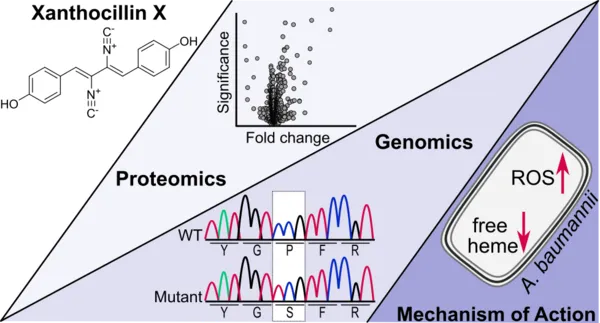New Publication in ACS Central Science

Isonitrile natural products exhibit promising antibacterial activities. However, their mechanism of action (MoA) remains largely unknown. Based on the nanomolar potency of xanthocillin X (Xan) against diverse difficult-to-treat Gram-negative bacteria, including the critical priority pathogen Acinetobacter baumannii, we performed in-depth studies to decipher its MoA. While neither metal binding nor cellular protein targets were detected as relevant for Xan’s antibiotic effects, sequencing of resistant strains revealed a conserved mutation in the heme biosynthesis enzyme porphobilinogen synthase (PbgS). This mutation caused impaired enzymatic efficiency indicative of reduced heme production. This discovery led to the validation of an untapped mechanism, by which direct heme sequestration of Xan prevents its binding into cognate enzyme pockets resulting in uncontrolled cofactor biosynthesis, accumulation of porphyrins, and corresponding stress with deleterious effects for bacterial viability. Thus, Xan represents a promising antibiotic displaying activity even against multidrug resistant strains, while exhibiting low toxicity to human cells.
Hübner, I.*, Shapiro, J. A., Hoßmann, J., Drechsel, J., Hacker S. M., Rather, P. N., Pieper, D. H., Wuest, W. M., Sieber S. A., "Broad spectrum antibiotic Xanthocillin X Effectively Kills Acinetobacter baumanii via dysregulation of heme biosynthesis", ACS Cent. Sci.
Link: https://doi.org/10.1021/acscentsci.0c01621
Copyright American Chemical Society. Reproduced with permission.